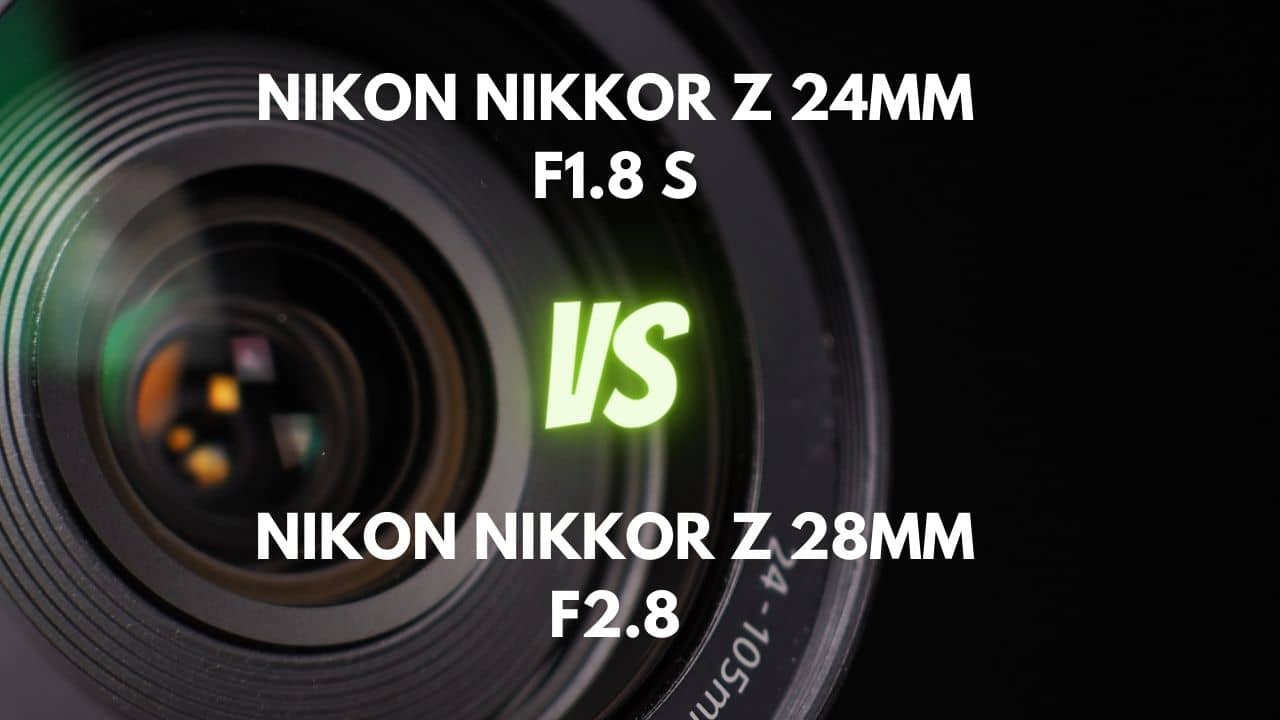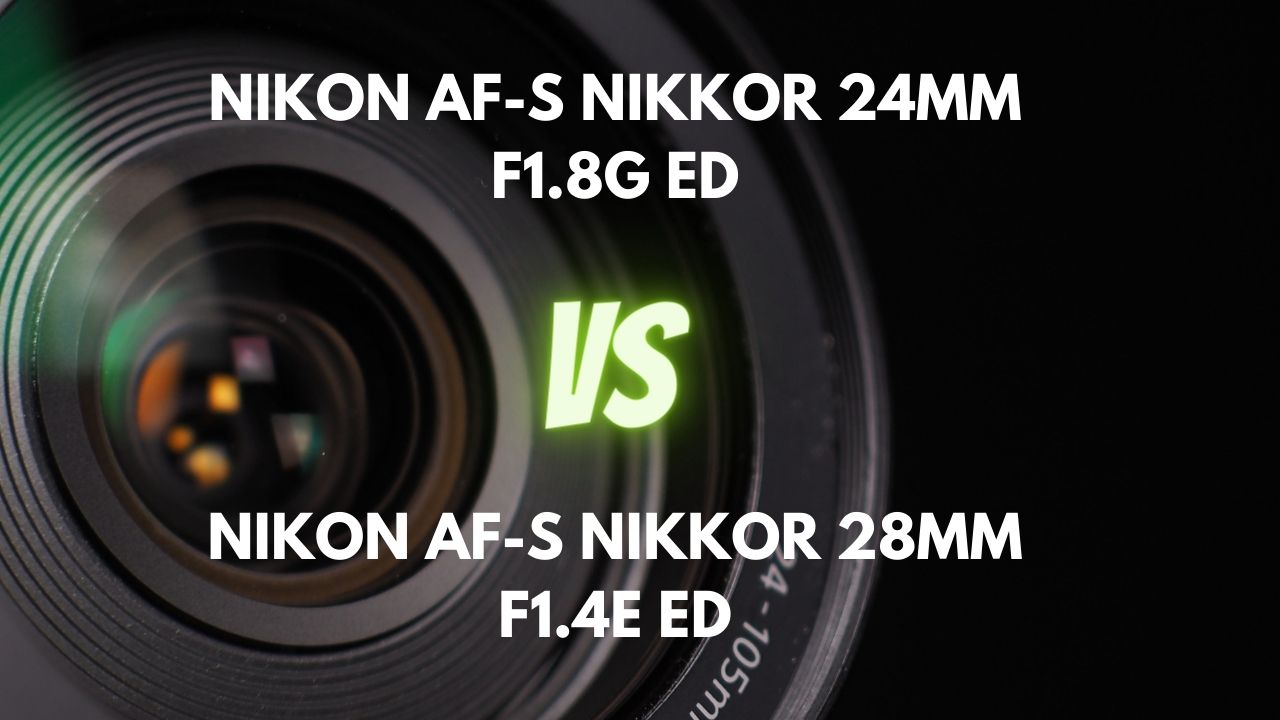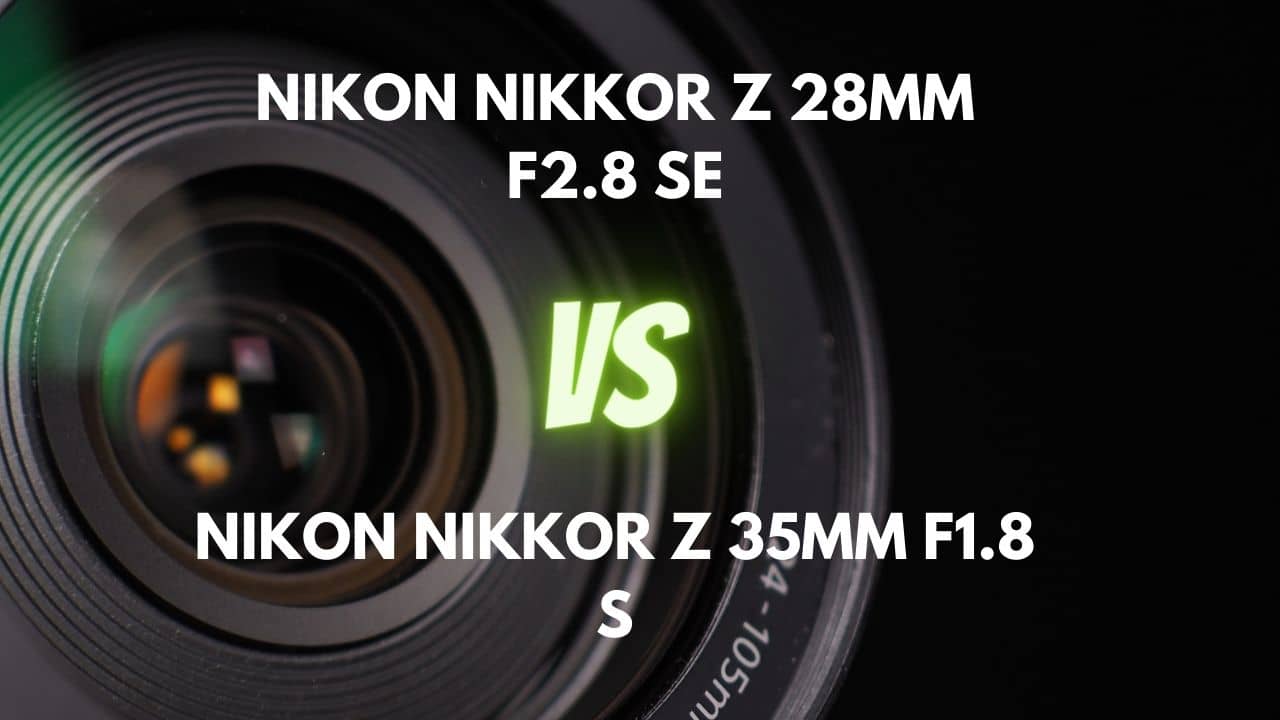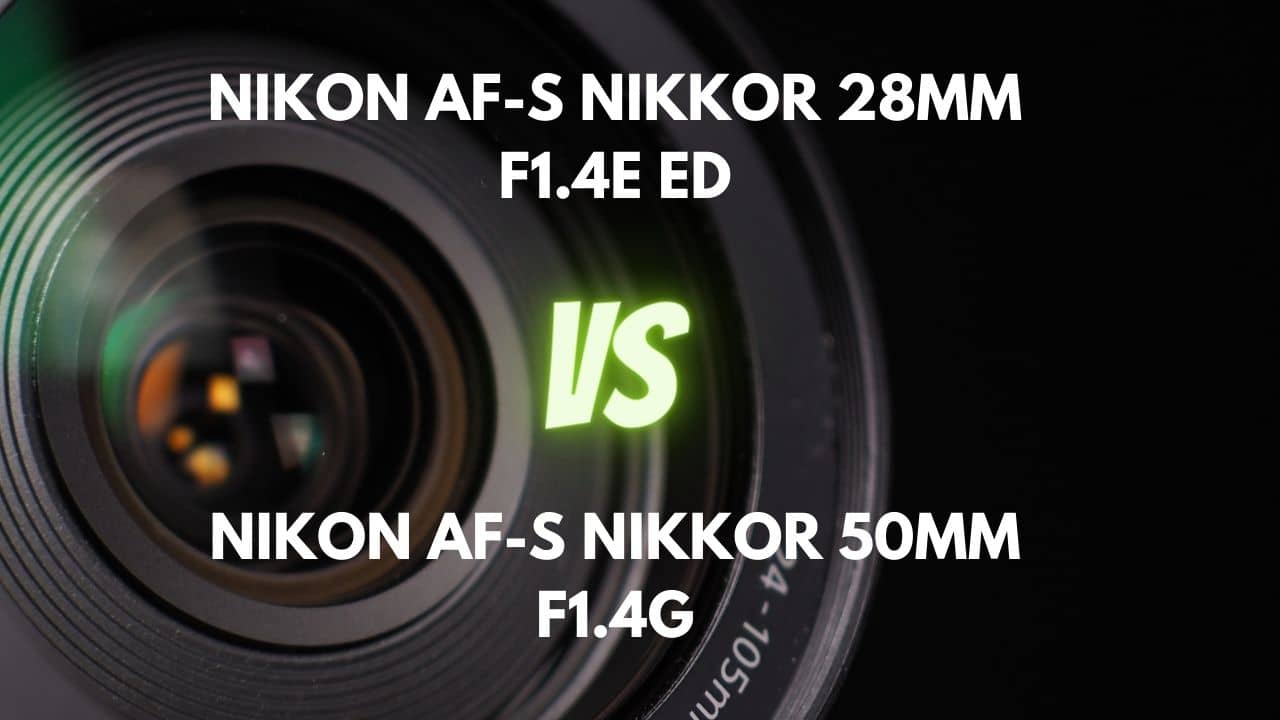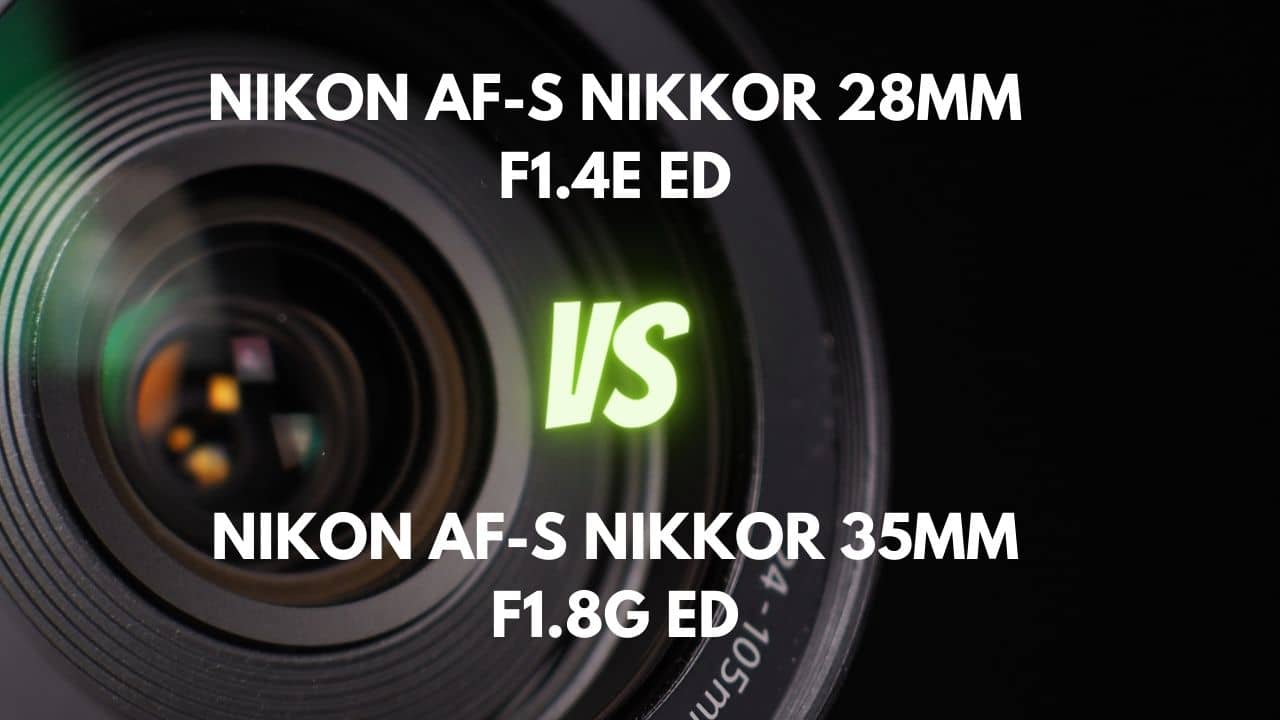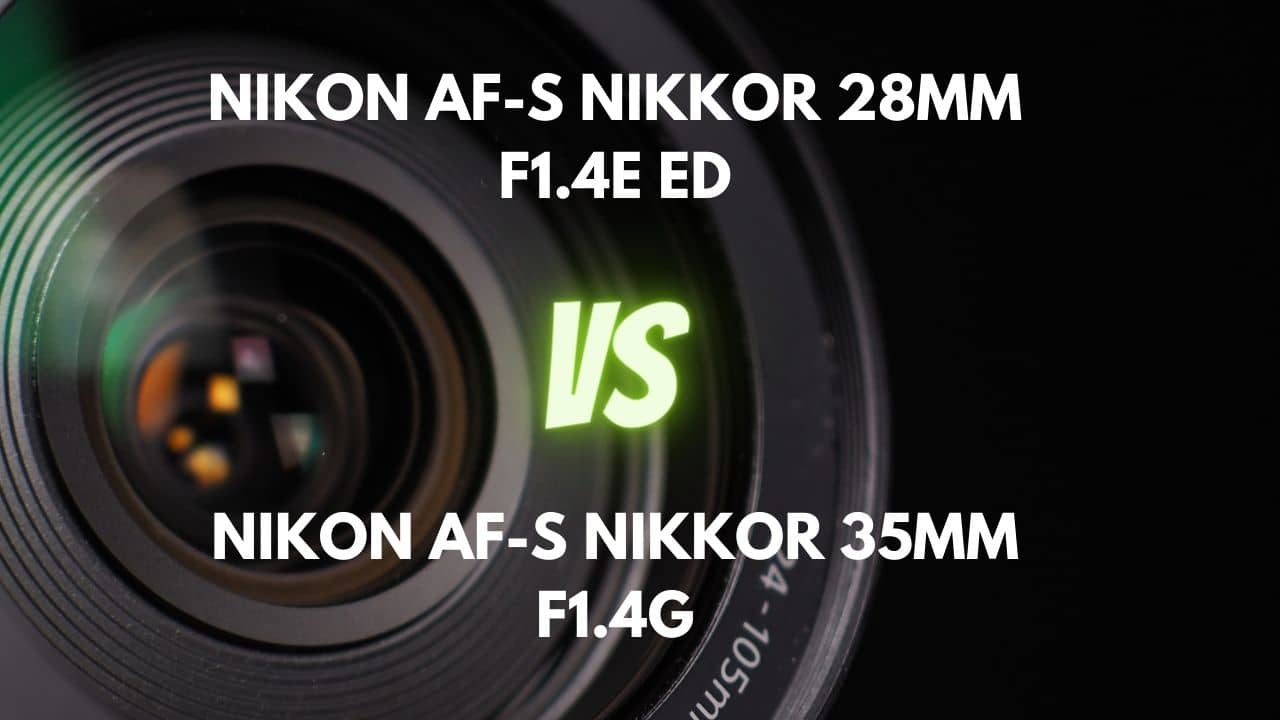Welcome, photography enthusiasts, to a deep dive into the world of wide-angle lenses!
Today, we’re exploring the realm of the Nikon Z 24mm f/1.8 and Nikon Z 28mm f/2.8 SE – two powerhouses that have been captivating photographers’ hearts across the globe. Whether you’re a seasoned professional or a passionate amateur, there’s a high chance these lenses have crossed your path, or at least made a cameo in your photography dreams.
Why, you ask? It’s simple – versatility. From capturing sweeping landscapes that take your breath away, to immortalizing cityscapes with their architectural grandeur, these lenses offer an impressive array of creative possibilities. Their wide field of view can convey the grandiosity of the cosmos in astrophotography or deliver an intimate environmental portrait that tells a compelling story.
But how do you choose between these two? How do you know whether the 24mm’s wider field of view or the 28mm’s lighter weight and distortion management will better serve your artistic vision? Well, that’s precisely where we come in. With our in-depth comparison of these two optical gems, you’ll be equipped with the knowledge to make an informed decision tailored to your unique needs.
By the end of this article, not only will you understand the unique strengths and limitations of each lens, but you’ll also gain a clearer picture of how these characteristics can affect your photography. So, prepare to delve into the nitty-gritty of lens specifications, performance tests, and real-world applications – all in a quest to find the perfect partner for your photography journey.
Let’s get started, shall we?
Overview
| Nikon NIKKOR Z 24mm F1.8 S | Nikon NIKKOR Z 28mm F2.8 SE | |
|---|---|---|
| Max Aperture | F1.8 | F2.8 |
| Aperture Type | Fixed | Fixed |
| Focal Range (mm) | 24 | 28 |
| Mount Type | Nikon Z | Nikon Z |
| Max Format | 35mm FF | 35mm FF |
When comparing the Nikon Z 24mm f/1.8 and Nikon Z 28mm f/2.8 SE, both are wide-angle lenses suitable for Nikon Z mount cameras and are capable of being used on a 35mm Full-Frame (FF) format. However, they differ in several aspects, including maximum aperture and focal range.
The 24mm lens has a maximum aperture of f/1.8, which is larger than the 28mm lens’s maximum aperture of f/2.8. This larger aperture allows the 24mm lens to allow more light to enter the camera, improving low light performance. It also gives this lens the ability to create a shallower depth of field, helpful for isolating subjects and creating a pleasing background blur. However, with wide-angle lenses, a larger aperture can sometimes lead to more lens aberrations and distortion, particularly at wider focal lengths. Furthermore, lenses with larger apertures are generally larger, heavier, and more expensive.
On the other hand, the 28mm lens, with its smaller aperture, might not perform as well in low light conditions, but it could also provide a deep depth of field, beneficial for landscape and architectural photography where you need to keep the entire scene in focus.
Both lenses possess a fixed aperture, ensuring a consistent maximum aperture across the entire zoom range. This feature enables reliable performance even when shooting in different lighting conditions. Fixed aperture lenses, like these two, typically yield better image quality, reduced distortion, and less chromatic aberration, especially when compared to variable aperture lenses.
In terms of focal range, the 24mm lens offers a wider field of view than the 28mm lens. This could make it more suitable for capturing expansive landscapes, large group portraits, or tight interior spaces. Conversely, the 28mm lens, while still considered a wide-angle lens, offers a slightly narrower field of view, which could make it a better choice for street photography or situations where a bit more reach is beneficial.
In summary, the 24mm lens with its larger aperture and wider field of view might be a better choice for low light photography, capturing wide landscapes, or creating images with a shallower depth of field. However, its larger aperture might introduce more distortion and it is likely to be larger, heavier, and more costly. The 28mm lens, while not as adept in low light situations, is a suitable option for street or architectural photography.
Design and Ease of Use
| Nikon NIKKOR Z 24mm F1.8 S | Nikon NIKKOR Z 28mm F2.8 SE | |
|---|---|---|
| Diameter x Length (mm) | ⌀78×96.5mm | ⌀71.5×43mm |
| Weight (gr) | 450 | 160 |
| Filter Thread (mm) | 72 | 52 |
| Weather Sealing | Yes | No |
| Distance Scale | No | No |
| DoF Scale | No | No |
| Hood Supplied | Yes | No |
The Nikon Z 24mm f/1.8 and Nikon Z 28mm f/2.8 SE, while both wide-angle lenses, vary significantly in their dimensions and weight, which can impact their usability and handling in different photography scenarios.
The 24mm lens, with a diameter of 78mm and length of 96.5mm, is considerably larger than the 28mm lens, which has a diameter of 71.5mm and a length of 43mm. Consequently, the 24mm lens weighs in at 450 grams, almost three times the weight of the 28mm lens at 160 grams.
Given its larger size and weight, the 24mm lens is more difficult to carry around for extended periods. It could potentially make your camera setup feel front-heavy and unbalanced, which might lead to discomfort during prolonged shoots. Additionally, the larger size of this lens could make it more conspicuous, which might not be ideal for discreet shooting scenarios like street photography. However, this lens could offer more robust build quality, often associated with larger lenses, which could potentially withstand more rigorous usage.
On the other hand, the 28mm lens, with its smaller dimensions and lighter weight, offers greater portability. This could be beneficial for photographers who travel frequently or for those who prefer lighter gear for extended shooting sessions. Its compact size also allows for more space in your camera bag and less weight to carry around. Moreover, its smaller footprint could provide a better balance when mounted on a camera, leading to more comfortable handling. This lens’s discreetness could also be an advantage in street photography, where blending into the environment can be crucial for capturing candid shots.
In conclusion, if size and weight are major considerations for you, the 28mm lens is clearly the superior option, offering better portability, balance, and discreetness. However, if these factors are less important to you, the 24mm lens might be acceptable, especially if you value the potential robustness associated with its larger build.
Lens Mount and Barrel
The lens mount of the Nikon Z 24mm f/1.8 is built of robust metal, featuring four locking ears for a secure and stable connection to the camera body. This design minimizes lens tilting and enhances the stability of the entire camera system. Additionally, the inclusion of a rubber gasket provides an extra layer of protection against dust and debris, a feature that is particularly beneficial for outdoor and rugged use.
On the contrary, the lens mount of Nikon Z 28mm f/2.8 SE is constructed from high-quality plastic. Although not as durable as metal, the plastic mount is expected to withstand wear and tear over time. However, the lack of a rubber gasket, common in many lenses for weather sealing, could potentially leave it more vulnerable to dust and water. It compensates with a hard plastic lip for basic protection, but this may not be as effective as a rubber gasket.
Turning to the lens barrel, the 24mm lens adopts a hybrid construction, blending metal and plastic components. The rear section is metal, offering a premium feel and durability, while the plastic sections, though solid, don’t match the high-quality feel of metal. The lens employs an internal focusing mechanism, which is beneficial for maintaining a constant size and using filters without problems.
The 28mm lens, however, uses a high-quality plastic barrel. Despite the plastic construction, it maintains a robust feel, and its slim, immobile sections contribute to a streamlined and ergonomic design. The matte black finish provides a seamless match with most camera bodies, while enhancing the handling experience.
In essence, if durability and stability are your top priority, the 24mm lens, with its metal mount and hybrid barrel, seems to be the superior choice. However, if you prioritize lightweight construction and user-friendly design, the 28mm lens, with its plastic mount and barrel, may be more appealing.
Weather Sealing
The Nikon Z 24mm f/1.8 boasts comprehensive weather sealing, using separate rubber rings across the lens to safeguard against dust and moisture. The presence of a gasket at the lens mount and internal seals at the rings, switches, and the front of the barrel provides all-around protection. However, the lack of a grease-repellent fluorine coating on the front element slightly reduces its resistance to environmental elements, as it could lead to easier accumulation of water and dust.
In contrast, the Nikon Z 28mm f/2.8 SE employs a more limited approach to weather sealing, primarily inside the barrel. Internal seals around the focus ring and the front end provide resistance against dust and water intrusion. However, the absence of a rubber gasket at the lens mount could hinder its full potential to resist environmental elements, particularly in more challenging conditions. Like the 24mm lens, the 28mm lens also lacks a fluorine coating on the front element, which could lead to dust and water clinging to it more readily.
In essence, weather sealing is a significant consideration for lenses, particularly for photographers who frequently shoot in various outdoor environments. It provides a valuable layer of protection, ensuring durability and optimal performance in diverse conditions. Considering the features of both lenses, the 24mm lens, with its extensive weather sealing, appears to be the superior choice in this regard. Remember, even the best weather sealing doesn’t make a lens waterproof, so always exercise caution when shooting in harsh conditions.
Rings
The Nikon Z 24mm f/1.8 sports a single, broad manual focus ring around the mid-section of the barrel. The metal construction coupled with fine ribbing ensures a firm grip and smooth operation, allowing for precise manual focusing. Despite lacking hard stops and distance scale or depth-of-field indicators, the lens compensates by displaying a focus scale either in the viewfinder or on the camera screen during manual focus mode. It also leverages the “focus-by-wire” technology, enabling customization of the ring’s function through the camera menu. While there isn’t a dedicated control ring, the manual focus ring’s tactile experience and ergonomic design render it straightforward and enjoyable to use.
On the other hand, the Nikon Z 28mm f/2.8 SE features a dual-ring system: a narrow, ribbed silver manual focus ring and a larger rubber-ribbed focus ring. The rings, located at the front of the lens, offer a seamless rotation for precise settings. The larger focus ring operates on a focus-by-wire system, with a focus throw that adjusts depending on the speed of rotation. This versatile ring also doubles as a control ring, making it possible to tweak aperture, ISO, or EV compensation in autofocus mode. However, the high sensitivity of the control ring might cause inadvertent changes in exposure settings. The ribbed design on the rings ensures a solid grip, while the smooth rotation and ergonomic bevel enhance the lens’s handling experience.
In sum, both lenses have their strengths: the 24mm lens with its single, large, customizable ring and the 28mm lens with its dual-ring system. Ultimately, the decision between the two lenses boils down to personal preference and shooting style. If you prefer a single, broader ring that provides an excellent grip and can be customized, the 24mm lens is a great choice. However, if you favor having two separate rings with varied functionality, the 28mm lens could be the more appealing option. Both designs offer precision and control, contributing to an overall comfortable and effective shooting experience.
Switches/Buttons
The Nikon Z 24mm f/1.8 adopts a minimalist design with a single switch for managing the focus mode. This AF/MF switch, conveniently positioned on the side of the lens, enables users to swiftly shift between autofocus and manual focus. This straightforward design allows for quick adjustments during shooting and fosters a user-friendly experience for photographers, eliminating potential complications.
Contrarily, the Nikon Z 28mm f/2.8 SE, also with a minimalist design, opts for an absence of physical switches and buttons. Notably, it lacks an AF/MF switch, implying that users need to manipulate AF settings on the camera itself to disable autofocus. This could pose an inconvenience to some users who favor tangible, instantaneous control over the focus mode.
Nonetheless, the lens compensates for this with its versatile control ring. This ring, customizable to operate the aperture, exposure compensation, ISO, or focus, offers flexibility. In manual focus mode, the ring automatically reverts to its default focus control. Thus, despite the scarcity of physical switches or buttons, the lens embraces a streamlined, user-friendly design philosophy that empowers photographers to concentrate more on their creativity rather than navigating intricate lens controls.
In conclusion, while both lenses espouse a minimalist design, the 24mm lens may be more appealing to photographers who prefer immediate, physical control over focus modes due to its AF/MF switch. However, if versatility in control is your priority, the 28mm lens with its multi-function control ring presents a compelling case.
Filter Thread
The Nikon Z 24mm f/1.8 boasts a filter thread size of 72mm, fabricated from plastic. Its front element remains static during focusing, a desirable feature when using filters such as polarizers or graduated filters. This non-rotating design upholds consistent adjustments to filters throughout the focusing process, ensuring an uninterrupted workflow for photographers. However, bear in mind that the larger filter thread size may result in higher costs for corresponding filters.
In contrast, the Nikon Z 28mm f/2.8 SE comes with a smaller 52mm filter thread, also made of plastic. This smaller size can lead to cost savings when purchasing filters, lending a degree of economic advantage to photographers. Similar to the 24mm lens, its filter thread does not rotate during focusing, maintaining the desired effects of filters like polarizers irrespective of focus adjustments. A notable feature is its capacity to stack multiple regular 52mm screw-in filters without causing vignetting on full-frame, expanding creative possibilities. However, users who prefer to use more prevalent 62mm+ filters will need a step-up ring to ensure compatibility. While the plastic thread is generally of good quality, photographers should be cautious not to cross-thread or over-tighten filters, to avoid potential damage.
In conclusion, if filter size versatility and the ability to stack multiple filters without vignetting are your priorities, the 28mm lens with its 52mm filter thread stands out as the superior choice. However, if you prefer a larger filter size and already have a collection of 72mm filters, the 24mm lens could be a better fit for your needs. The decision, therefore, largely hinges on your personal preferences and existing gear.
Lens Hood
The Nikon Z 24mm f/1.8 comes with a lens hood in the box, enhancing the overall package value. The hood, crafted from plastic, features a petal-type design that can effectively shield the lens from stray light, minimizing flare and improving image contrast. The bayonet mount facilitates smooth attachment and detachment, allowing for easy rotation when necessary. Additionally, the hood can be reversed to conserve space during transportation or storage. The lens hood’s beveled edge enhances grip, and the lightweight plastic construction contributes to the overall portability of the lens.
Contrarily, the Nikon Z 28mm f/2.8 SE does not include a lens hood in its package. Despite this, it accommodates generic 52mm threaded hoods, offering the flexibility to users who wish to add a lens hood for added protection or flare management. Importantly, the lens itself exhibits good resilience against flare, mitigating the immediate need for a hood under many shooting conditions.
In conclusion, the 24mm lens delivers a superior experience in terms of lens hood provision, given its included, user-friendly petal-type hood that adds value to the package and enhances ease of use. However, the 28mm lens’s compatibility with generic 52mm threaded hoods still offers flexibility for those who deem a lens hood necessary, despite not being included in the package.
Focusing and Optical Stabilization
| Nikon NIKKOR Z 24mm F1.8 S | Nikon NIKKOR Z 28mm F2.8 SE | |
|---|---|---|
| Autofocus | Yes | Yes |
| AF Motor | Stepper motor | Stepper motor |
| Rotating Front Element | Does not rotate on focusing | Does not rotate on focusing |
| Min Focus Distance | 0.25m | 0.19m |
| Max Magnification (X) | 0.15 | 0.2 |
| Full-Time Manual Focus | Yes | Yes |
| Focus Method | Internal | Internal |
Focusing Performance
The Nikon Z 24mm f/1.8 boasts excellent autofocus performance, characterized by quiet operation and swift focusing. It can transition focus from infinity to 0.32m in about half a second, which is quite speedy. Its performance excels in well-lit conditions, demonstrating negligible hunting. The lens’s high focus accuracy, with a repeatability of 99.0%, as measured in Reikan FoCal, assures sharp images.
Its manual focus override is a valuable feature, allowing users to fine-tune focus with ease, thanks to the smooth action of the focusing ring. The internally focusing design of the lens ensures consistent lens length, irrespective of focus and zoom settings. A notable attribute of this lens is its minimal focus breathing, making it an attractive option for video applications.
The Nikon Z 28mm f/2.8 SE, on the other hand, is equipped with a robust autofocus system that delivers impressive speed and accuracy, attributed to the stepping motor. The focusing response time of 0.2 to 0.4 seconds, albeit fast, may result in missed moments for candid or moving subjects. The lens operates quietly, with the noise described as a low buzz, beneficial for scenarios requiring silence, although the built-in microphone might pick up some noise during video recording. The lens’s prowess in low-light conditions, due to its f/2.8 maximum aperture, adds to its versatility. Its autofocus accuracy is commendable, with no reported front or back focus tendencies.
The manual focus override feature is intuitive, responsive, and allows for precise adjustments. The internally focusing design keeps the lens length constant, avoiding potential balance issues. The lens does demonstrate some focus breathing, which might be a distraction for videographers but is generally not a significant issue for still photography.
In conclusion, while both lenses perform admirably, the 24mm lens, with its swift, accurate, and quiet performance, as well as minimal focus breathing, edges out slightly over the 28mm lens, making it the superior choice in terms of focusing performance.
Optical Stabilization
The Nikon Z 24mm f/1.8 does not come equipped with inbuilt optical stabilization. However, it takes advantage of the in-body image stabilization (IBIS) when paired with Nikon Z cameras. This gives photographers an impressive 5 stops of stabilization across all five axes, including pitch, yaw, roll, X, and Y movements. In practice, this can lead to 4-6 stops of improvement over the standard reciprocal rule for shutter speed and focal length, a significant boost in image sharpness. This compatibility with the camera’s IBIS also means shutter speeds can be extended up to a full second for handheld shots, which is remarkable for this type of lens. The lens operates quietly, so any noise from the stabilization system shouldn’t be an issue.
In contrast, the Nikon Z 28mm f/2.8 SE also lacks internal optical stabilization but depends on the camera body’s stabilization capabilities. Whether it’s Internal sensor-shift Image Stabilization (IS) or Vibration Reduction (VR), these features can aid in producing sharper images at slower shutter speeds. In practical terms, you may witness a two-stop real-world improvement with this lens, enabling you to shoot at shutter speeds four times slower while maintaining sharpness. However, this lens does not offer any noise or vibration reduction within its system.
While both lenses leverage the stabilization features of the camera body, the 24mm lens offers a more advanced utilization of the in-body image stabilization system, giving it an edge over the 28mm lens.
Image Quality
| Nikon NIKKOR Z 24mm F1.8 S | Nikon NIKKOR Z 28mm F2.8 SE | |
|---|---|---|
| Special Elements | 1 ED + 4 aspherical elements, Nano Crystal and Super Integrated coatings | 2 aspherical elements |
| Diaphragm Blades | 9 | 7 |
Aberration
The Nikon Z 24mm f/1.8 shows some susceptibility to chromatic aberration, particularly longitudinal chromatic aberration, which is more noticeable at its widest aperture and slightly reduced when the aperture is narrowed by one stop. However, it fares better in controlling lateral chromatic aberration.
The lens also demonstrates some issues with coma aberration, seen as smearing around bright points of light when shooting at the widest aperture, but this issue lessens when the aperture is reduced to f/2.8 or f/4. It also exhibits some spherical aberration, evidenced by a discernible rimming effect in out-of-focus light circles, impacting the bokeh and out-of-focus areas’ sharpness. Despite these deficiencies, the lens generally performs well across different shooting scenarios.
In contrast, the Nikon Z 28mm f/2.8 SE excels in its correction of longitudinal chromatic aberration, making out-of-focus colorations nearly indistinguishable even at the widest aperture. Its control over lateral chromatic aberration is commendable, maintaining it at barely perceptible levels.
Its performance with coma aberration is satisfactory, making it a good candidate for astrophotography, despite some minor presence of coma. It effectively minimizes spherical aberration, as demonstrated by the absence of noticeable focus shift and uniformity in the appearance of out-of-focus light circles. However, the lens does display some spherochromatism, a complex form of spherical and chromatic aberration, leading to colored fringes in out-of-focus areas when shooting wide open. Despite this, chromatic aberrations are well handled in both JPG and Raw files.
In conclusion, when it comes to aberration handling, the 28mm lens holds a slight advantage. Its superior control over longitudinal chromatic aberration and effective management of other aberrations make it a more reliable choice for image clarity and quality. While both lenses exhibit certain aberration issues, the 28mm lens’s comprehensive aberration management offers a better performance, making it the superior choice in this comparison.
Sharpness
The Nikon Z 24mm f/1.8 presents robust center sharpness, particularly at f/4, where it peaks and displays superior clarity. The corners are slightly less sharp, showing some acuity fall-off, but this improves when the aperture is narrowed past f/2.8. When shooting wide open at f/1.8, the lens remains quite sharp, with marginal enhancements noted at f/2 and f/2.8. However, diffraction can cause softening when the aperture is closed down to f/11 or f/16. The lens’s sweet spot for sharpness lies between f/4 and f/8.
Contrastingly, the Nikon Z 28mm f/2.8 SE delivers consistently remarkable center sharpness across all apertures. However, contrast may decrease towards the corners of a full-frame image due to sagittal coma flare at f/2.8. This issue resolves by f/5.6. The lens begins a little soft at f/2.8 but improves notably at f/4, especially in the center and corners. It reaches optimal sharpness at f/5.6 and then gradually decreases as you stop down to f/16 due to diffraction. The lens also displays some field curvature which may affect sharpness for subjects at similar focusing distances. At wide open f/2.8 on a full-frame camera, the lens provides very good sharpness, extending even to the frame edges. The lens’s best edge sharpness is obtained between f/4 and f/11.
In conclusion, both lenses offer appreciable sharpness, but the 24mm lens displays superior center sharpness, particularly at f/4. The 28mm lens offers consistent center sharpness across all apertures but shows a slight contrast decrease at the corners. Considering the overall sharpness across the aperture range and the frame, the 24mm lens edges out the 28mm lens in this comparison, although the latter still provides satisfactory sharpness for its intended uses.
Bokeh Quality
The Nikon Z 24mm f/1.8 creates a generally pleasing bokeh with soft out-of-focus areas and well-rendered light circles. However, it does exhibit some bokeh-related issues. These include mild onion rings, which can give bokeh circles a layered or ringed appearance, green outlining due to longitudinal chromatic aberration, and more pronounced edges on specular highlights caused by aspherical lens elements. These elements can subtly affect the smoothness and uniformity of the bokeh. Furthermore, this lens presents a moderate cat’s eye effect towards the frame’s corners when shot wide open, which can distort the bokeh shapes from circular to more elliptical.
On the other hand, the Nikon Z 28mm f/2.8 SE also produces a pleasing bokeh, especially impressive for a moderately wide-angle lens with a maximum aperture of f/2.8. The out-of-focus highlights are smooth and not sharply defined, thanks in part to the lens’s seven rounded blades on the iris diaphragm. These contribute to a more circular and appealing out-of-focus area. The bokeh becomes even more pronounced and attractive when focusing closely on small subjects. However, there are some weaknesses. There is some level of outlining with a bit of coloration and weak onion rings, especially when the lens is stopped down to f/4.0, which may result in non-circular bokeh balls. Yet, despite these minor drawbacks, the bokeh quality of this 28mm f/2.8 lens is still quite commendable.
In conclusion, both lenses are capable of producing pleasing bokeh, which is an achievement for wide-angle lenses. If one had to choose, the 28mm lens might edge out slightly due to its ability to create smoother and more circular out-of-focus highlights, despite its minor shortcomings when stopped down. However, bokeh quality can be subjective and dependent on specific shooting scenarios and photographer preferences.
Flare/Ghosting
The performance of the Nikon Z 24mm f/1.8 and 28mm lenses in terms of flare and ghosting showcases the capabilities of these two lenses in managing light artifacts.
The 24mm lens demonstrates impressive control over flare and ghosting, even when faced with challenging lighting situations. This is largely attributed to Nikon’s Nano Crystal Coat, a specialized lens coating that effectively curbs internal reflections across a spectrum of wavelengths, thereby significantly minimizing flare and ghosting.
The lens has proven its mettle in field tests, performing exceptionally well when shooting against the sun, with no substantial issues observed that might compromise image quality. Although the light’s angle and the sun’s position can typically trigger flare and ghosting, this lens handles these potential problems adroitly, thanks to its high-quality lens coatings.
On the other hand, the Nikon Z 28mm f/2.8 SE also exhibits admirable resistance to flare and ghosting, despite lacking an official hood. During rigorous testing against a robust light source, the lens produced images with minimal glare and ghosting. Even with the use of several standard 52mm screw-in filters, vignetting on full-frame is avoided, and no noticeable ghosts or flare are introduced. This is an advantageous feature, particularly for photographers who want to utilize standard rotating polarizer and grad filters without worrying about flare and ghosting.
Nonetheless, in certain challenging lighting conditions, the lens has displayed some minor ghosting artifacts and a degree of flare, including a noticeable red dot flare when the sun is within the frame. Furthermore, the lens occasionally produces indistinct, blob-like sunstars rather than well-defined ones, which might be disappointing for photographers looking to capture sharp sunstars in their images.
In conclusion, both lenses have their strengths when it comes to handling flare and ghosting. However, the 24mm lens, with its effective Nano Crystal Coat and strong performance in field tests, has a slight edge over the 28mm lens, which despite its commendable performance, has shown a few more instances of light artifacts under challenging lighting conditions.
Vignetting
The Nikon Z 24mm f/1.8 shows significant vignetting at wider apertures, especially at f/1.8. However, decreasing the aperture to f/2.8 significantly curtails the vignetting, and by the time you reach f/4, it is mostly eliminated. For shots focusing at or near infinity, using an aperture of f/4 or smaller is recommended to minimize vignetting. While the lens manages vignetting reasonably well for most types of photography, those specializing in landscape and architecture might find it more bothersome, particularly when using wider apertures. Thankfully, in-camera corrections can be utilized to further alleviate the vignetting issue.
Conversely, the Nikon Z 28mm f/2.8 SE reveals noticeable vignetting, especially when paired with a full-frame camera at wider apertures. At f/2.8, there’s a substantial light fall-off in the corners, which starts to lessen considerably as you stop down the aperture. By f/4, vignetting becomes much less troubling. In-camera vignette control settings can be deployed to further reduce this effect, but even with the settings adjusted to normal, a bit of light fall-off can still be detected in the corners at f/2.8. For the most evenly lit image, it’s advised to either use the high vignette control setting or stop down the aperture to at least f/4 or f/5.6, where the vignetting effect becomes negligible.
On a DX camera, such as the Nikon Z fc or Nikon Z 50, vignetting is considerably less pronounced due to the crop sensor. When it comes to filter usage, stacking several regular 52mm filters doesn’t introduce noticeable vignetting on a full-frame sensor. Nonetheless, this lens has a tendency to retain relatively high levels of vignetting even at narrower apertures, more so than comparable lenses.
Given these comparisons, it’s clear that both lenses exhibit some degree of vignetting at wider apertures. However, the 24mm lens controls the vignetting better as the aperture is stopped down, while the 28mm lens tends to keep relatively higher levels of vignetting, even at narrower apertures. Therefore, the 24mm lens appears to be superior in terms of managing vignetting.
Distortion
The Nikon Z 24mm f/1.8 and 28mm lenses both exhibit some degree of distortion, which is a typical characteristic of wide-angle lenses. However, the way each lens manages this distortion and how it may affect your photography varies.
The 24mm lens displays moderate barrel distortion, with measurements ranging from around -1.34% to 2.33% based on specific conditions. This level of distortion is not overly pronounced in most images. However, for some types of photography, such as architectural shots, you might need to apply corrections, particularly if you notice wavy lines or mustache distortion. The good news is that popular post-processing software like Lightroom and Photoshop can automatically correct distortion, minimizing the need for manual adjustments. Despite the presence of some distortion, the 24mm lens performs admirably in most photographic scenarios, although minor corrections might be required for certain specialized applications.
On the other hand, the Nikon Z 28mm f/2.8 SE also shows moderate distortion, which is expected for a wide-angle prime lens. Though slightly higher than other Nikon Z series lenses such as the 24mm f/1.8 S and 35mm f/1.8 S, this distortion is typically not a significant concern. This is largely due to the fact that it can be easily corrected in post-processing with minimal side effects.
Without corrections, the barrel distortion might be noticeable, but automatic corrections applied in-camera or during raw file processing using software like Nikon NX Studio or Adobe Camera Raw can effectively manage this. Additionally, if you use Adobe Lightroom, the built-in distortion correction profile for this lens can handle any distortion so effectively that you may not even notice it. Thus, while the lens does present some distortion, a combination of in-camera corrections and post-processing tools ensure it’s well managed. This distortion is unlikely to negatively impact your photography, especially in wider scenes where the distortion can even contribute to the visual dynamic.
Considering these points, both lenses perform reasonably well in managing distortion.
Final Verdict
From the perspective of wide-angle photography, each lens has strengths that may make it more suitable for specific genres.
For landscape photography, a wider field of view is typically preferred to capture vast expanses. The 24mm lens with its wider field of view, superior center sharpness, and better management of vignetting is a great choice. Additionally, its better performance in handling flare and ghosting makes it excellent for shooting in challenging light conditions often encountered in outdoor scenarios.
Architectural photography demands attention to detail, minimal distortion, and excellent sharpness. While the 24mm lens offers superior center sharpness, the 28mm lens edges out slightly in distortion management, particularly with its compatibility with Adobe Lightroom’s built-in distortion correction. Therefore, the 28mm is a more suitable choice for architectural photography, considering that distortions can affect the perception of lines and angles in architectural structures.
In the realm of astrophotography, the ability to let in as much light as possible is crucial. Here, the 24mm lens, with its larger aperture, appears to be a superior choice. Its wider field of view allows for capturing a greater portion of the sky, and its better use of in-body image stabilization would be beneficial for long exposure shots typically used in astrophotography.
For environmental portrait photography, where the subject and their surroundings are equally important, the 28mm lens could be a better choice. Its more pleasing bokeh can help subjects stand out against the background, and its lighter weight and better portability make it easier to handle during longer shooting sessions.
Overall, both lenses have their strengths and weaknesses and are suitable for different types of wide-angle photography. The Nikon Z 24mm f/1.8 generally excels in landscape and astrophotography due to its wider field of view, larger aperture, and superior handling of vignetting and flare. The Nikon Z 28mm f/2.8 SE, on the other hand, performs better in architectural and environmental portrait photography with its effective distortion management and pleasing bokeh. Therefore, the choice between the two depends largely on your specific requirements and the genre of photography you intend to pursue.

